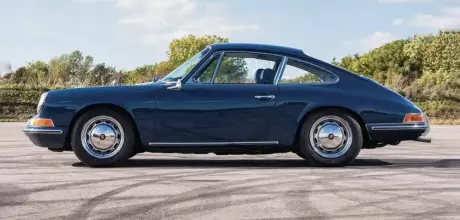Early Aga Blue 1965 Porsche 912 Coupé
This early Aga Blue 912 spent decades in the possession of the family behind the influential Pauter Machine Company before the car made its way to the UK, where it was subjected to full restoration...
Words Dan Furr
Photography Dan Sherwood
WHAT’S YOUR FLAVOUR?
A beautifully restored Aga Blue 912.
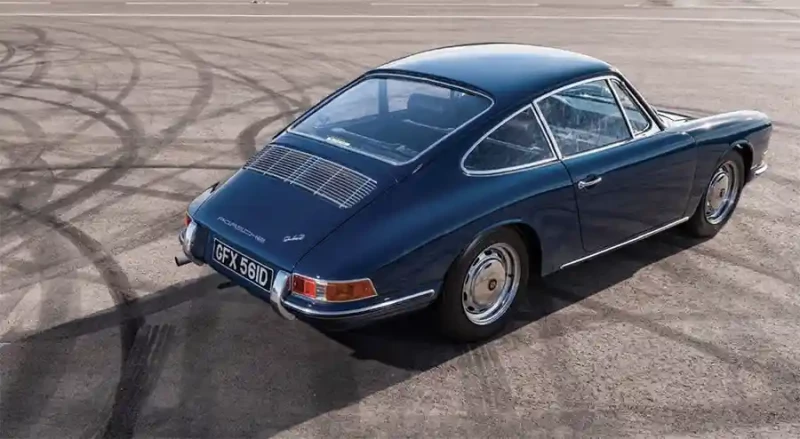
Can’t decide between heavily modified or standard specification? Afraid you’ll make the wrong decision? Perhaps you should do as Dave Lewis did and buy air-cooled Porsches of both persuasions? Not only is he the proud owner of the immaculate three-gauge Aga Blue 912 you see pictured on these pages, he’s also in possession of an S/T-aping 911 SC backdate powered by a 270bhp 911 Carrera 3.2 engine.
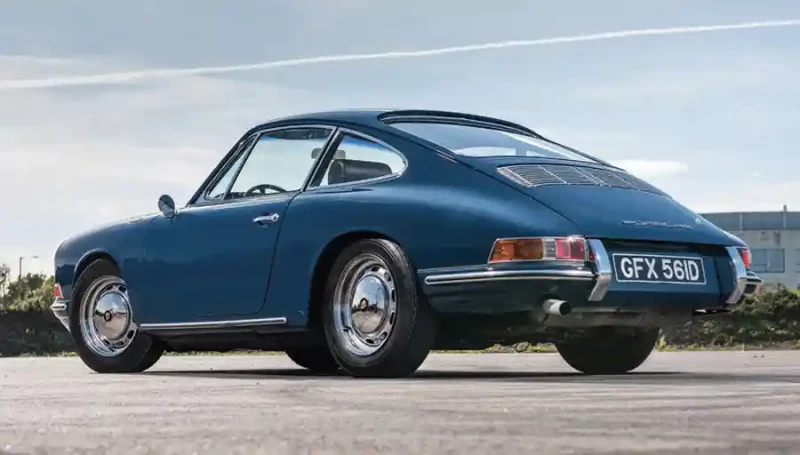
Nine years ago, he bought the four-cylinder Porsche from a company in Banbury specialising in importing aircooled Porsches from the USA. We’ve championed the 912 in previous issues of Classic Porsche, but beyond the model’s low price point (when compared to a same-age 911), what is this four-cylinder Porsche’s appeal? For the benefit of readers new to the 912, let’s delve deep.
Despite being a rear-engined sports coupé like the 356 before it, the 911 was always going to be a considerably more expensive proposition thanks to the introduction of a six-cylinder powerplant. Concerned the 911’s asking price — some thirty percent higher than the outgoing 356 — would reduce overall sales for the brand, Porsche pulled together a plan of action intended to produce a more affordable, four-cylinder version of its new car, thereby maintaining appeal for Porsche products among less affluent buyers. To keep development costs low, many of the same components, including the body shell, were used across both 911 and 912 production.

Initially given the factory designation 902 (to tie in with the 911’s original 901 identifier, which was changed to 911 after a challenge from Peugeot claiming ownership of three-digit model names with a zero in the middle), the 912 first appeared in 1965. It fulfilled its maker’s brief to the letter, combining the curvaceous looks of the then new 911 with a simpler, less powerful four-cylinder engine. Options explored, but ultimately discounted, included a new engine based on the flat-six, as well a unit derived from the Type 616/16 powerplant used to propel the 356 SC. In response to concerns about the little amount of cash Porsche had to play with, however, a detuned version of the 356’s regular 1.6-litre engine became the preferred choice. The resulting 616/36 featured cast-iron cylinder liners and a finned alloy jacket in addition to a light alloy crankcase and matching cylinder heads. A pair of twin-choke Solex carburettors and low compression ratio of 9.3:1 meant the new 1,582cc unit developed 90bhp at 5,800rpm.
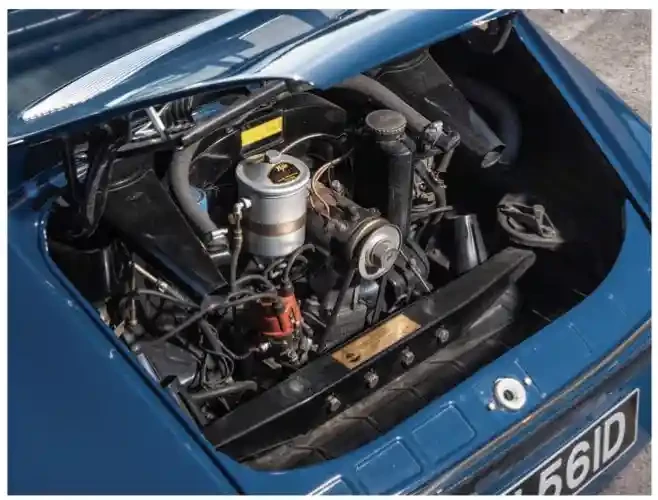
This was five ponies down when compared to the 356, but the 912’s engine delivered its 90lb-ft torque 700rpm lower than that of its predecessor. A Type 901 four-speed gearbox provided the drive, while 60mph was reached from a standing start in 11.6 seconds. Yes, the 912 was off the pace of the 130bhp 911, but the smaller-engined Porsche still managed to deliver respectable performance, especially at a time when drivers in the USA were experiencing enforced tightening of speed limits — at 115mph, the 912’s top speed was 16mph lower than that of its six-cylinder sibling, yet the smaller-engined Porsche was quicker and faster than the 356 due to a more aerodynamically optimised body and advanced-for-the-time independent suspension.
DIFFERENT STROKES
Looking at the 912 and 911 side-by-side, it may have seemed as if buyers were being short-changed, but Porsche was keen to highlight how the four-cylinder car offered considerable benefits over the brawny six-shooter. For starters, superior 44/56 front/rear weight distribution trumped the 911’s 41/59, while the 912’s more neutral handling meant it was less likely to bite at the limit. Helped by its lighter engine and overall weight of just 970kg, the 912 was also more economical, returning close to 35mpg. With a silver rear badge designed to let admirers know they weren’t staring at the model’s more powerful stablemate — 911s wore gold-coloured emblems — the 912 officially entered production on the 5th April 1965. At DM16,250 (£2,466), cost of ownership was DM6,000 (£972) less than a 911.
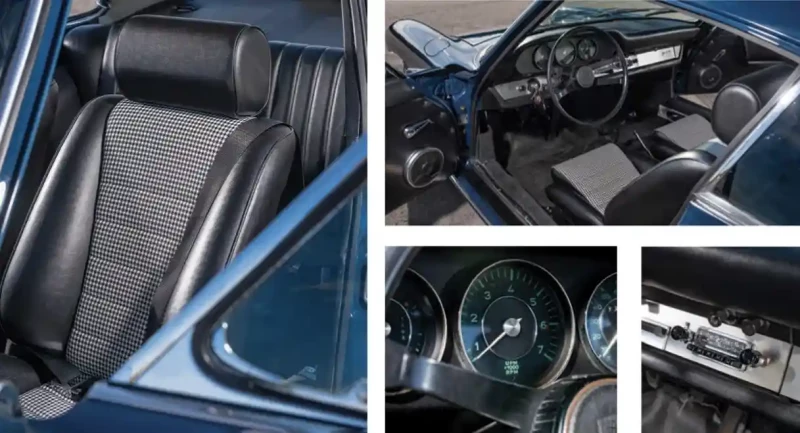
Porsche would soon discover it had a hit on its hands — by the close of 1965, 6,401 912s had rolled out of dealer showrooms. This figure is almost double the 911’s 3,390 sales volume for the same period. Interestingly, until production of the 356 ended in September of the same year, Porsche limited availability of the 912 to continental Europe, but from September onward, the model was available to buy in the USA. With a price tag of $4,700 against the top-line 911’s $6,500, sales success was assured.
Though it was built to attract buyers who couldn’t stretch to the pricier 911, the 912 was virtually indistinguishable from the more expensive Porsche. As mentioned earlier, the cars shared the same body, but also the same fifteen-inch wheels, 165HR tyres, brake discs and suspension. That said, these near identical Porsches could be told apart if you knew where to look. For example, the 912 made use of plastic interior trim, whereas wood was used for 911 cabin assembly. The bigger-engined car enjoyed the full complement of five dash dials, where buyers of the four-cylinder machine had to settle for three. Also, the 912 lacked the black plastic finish atop the 911’s painted dash, a feature inherited from the 356.
Patience paid off for would-be buyers when the five-dial instrument cluster became standard equipment for the 912 in 1967. Fuchs wheels became a cost option, allowing the entry-level Stuttgart speed machine to look even more like a 911 than it already did. Heightened specification, however, attracted heightened cost — in the UK, the price of acquiring a new 912 rose to £1,974, saving buyers only £462 over shelling out for a 911.
The 90bhp flat-four’s output was modest, especially when compared with the 911’s 130bhp, but in reality, the smaller-engined Porsche was pretty gutsy, not least because at just 970kg, it was positively lightweight when pitched against its 1,080kg six-cylinder sibling. Despite the 911’s flagship status, however, the four-cylinder model proved a commercial success, particularly in the North American market. Indeed, 912s were considerably more numerous than contemporary 911s, with 28,333 912 coupés and 2,562 912 Targas built against 22,768 of all types of 911 made between 1963 and 1969. Significantly, perhaps, the 100,000th Porsche to roll out of the Zuffenhausen plant was a 912 Targa (destined for Stuttgart’s traffic cops).
There’s also the driving experience to consider. Sixty years ago, the 911 wooed Porsche devotees with its two-litre six-pot screamer and its fresh new contours, but early short-wheelbase 911s had a reputation for on-the-limit, tail-happy handling, especially in the wet. It took the wizardry of a seriously skilled driver to demonstrate how to turn that quirk into an advantage. The 912, with its smaller and lighter flat-four engine, not to mention its mass located further inboard, was more confidence-inspiring, despite — or because of — being less powerful.
Tuned 912s can be made to go very well. Need proof? Rally star, Sobiesław Zasada, not only won the 1967 Polish Rally with a 912, he also used the model to score Group 1 category victory in the 1967 European Rally Championship. Reinforcing the point, Vic Elford won the Group 3 class in a 911 S.
END OF AN ERA
By 1969, the deal with Volkswagen to produce the 914 as a joint venture called time on the 912, which literally had to make way for the mid-engined roadster on the Porsche production line. From then on, the Targatopped two-seater was presented as the new entrylevel Porsche sports car. In any case, Zuffenhausen was confronting increasingly stringent US emissions legislation. This spelled trouble for the 912. Porsche also had to rationalise its product line-up — the deal with Wolfsburg meant the 914 was a given, and the 911 range by now comprised three models graded according to performance and trim: the T, E and S.
Under these circumstances, the 912 seemed like an anachronism. We hadn’t heard the last of it, though. In 1976, between the end of 914 production and delay of the incoming 924, the ‘baby 911’ resurfaced on the US market as the 912 E, complete with G-series impact bumpers, although as far as the cognoscenti were concerned, the comeback kid was pegged back by its Bosch L-Jetronic-injected 1,972cc flat-four, derived from the VW 411 and developing just 86bhp, less than the original 912. Only 2,099 9121 Es were manufactured, all left-hand drive. Famous owners include self-styled Wheeler Dealer, Mike Brewer.
Dave’s early 912 spent most of its life in California and was owned by the matriarch of the prominent Pauter family, famous for establishing the Pauter Machine Company, a pioneer in the design and development of high-performance engine components. “It was her daily driver from the 1970s through to the early 1990s, after which it was kept in dry storage, only emerging two decades later, when the previous owner took ownership and recommissioned the car. He enjoyed it for a few years until deciding to sell up in order to fund the purchase of a 993.” By this point in time, Aga Blue — a glorious solid hue — had given way to a variation of grey with a bronze tint. The exterior was tidy enough, providing you didn’t look too closely. “In truth, the car was pretty rotten underneath, despite spending most of its life on the West Coast.”
Dave continues. “Not long after taking delivery, I was introduced to Mick Pacey, proprietor of Bedfordshirebased independent classic Porsche restoration specialist, Export 56. He agreed to configure the car for British roads. The work included lowering the ride height from US specification, which leaves a huge gap between wheel arch and tyre. Immediately, the car looked and handled better than when I first got behind the wheel.”
A couple of years passed. Mick’s team dutifully took care of remedial work required for each of the 912’s annual MOT tests, but the writing was on the wall. “Long story short, he didn’t want me to keep nursing the car through its yearly health check. It was time to consider full restoration,” Dave recalls. Under different circumstances, this might have been a difficult pill to swallow — with the obvious exception of its engine, the 912 shares almost all its componentry with the sameage 911, meaning cost of parts and restoration is largely the same between models. Fortuitously, Dave bought his 912 back when the price of acquisition was low. Additionally, a rising tide carries all ships — with renewed interest in air-cooled 911s and values rising accordingly, the 912 enjoyed a sudden change of fortune, meaning the cost of restoring Dave’s car would be offset by the rapid rise in its financial worth.
FOUR TO THE FLOOR
“I was lucky enough to be in a position to cover the cost of a full nut and bolt rebuild,” he says. “Mick’s team was excellent throughout the project. The body was stripped and restored, and running gear components were either overhauled or renewed. Pleasingly, the engine proved to be in superb condition, so much so Mick reckons it’s the best 912 flat-four his team had seen.” Low mileage helped. “The car had covered little more than sixty thousand miles, although its interior was beyond saving. I ended up buying a set of replica 911 S seats.” Finished in black with houndstooth fabric, they’re period perfect, even if original specification included less sumptuous pews and a headrest for the driver only.
Chrome-finished wheels were another optional extra, but they were a mess when Dave first laid eyes on them. “They were originally four-and-a-half inches wide, but somebody had seen fit to have them banded in order to increase width to six inches. I had them returned to their original size. Instead of an application of fresh chrome, however, I took the wheels to a specialist wheel refinisher in Poole, where they were treated to a chromeeffect powdercoat.” Offering the same look, but with reduced maintenance and more resistance to corrosion, the finish is indistinguishable from chrome unless you’re looking closely.
Fortunately, there were no major surprises when the body was stripped. “As far as an old 911 or 912 is concerned, when the kidney bowls are gone, you have to accept the rest of the car is likely to be in poor order,” Dave smiles. “When it came to restoring my 912, every piece of corroded metal was dismissed and every non-functioning part was either restored or replaced. The work carried out by Mick’s team was phenomenal, resulting in one of the very best surviving early 912s.”
This three-gauge sixties smasher is certainly a looker, attracting attention everywhere it goes. “I’ve taken it to local shows, plus I’ve driven it to Belgium and back a couple of times, but the arrival of my S/T-styled 911 SC backdate put paid to extensive 912 use, although I’d like to enter the car into the Zoute Grand Prix, a high-end automotive, art and lifestyle festival spread across several locations in the municipality of Knokke-Heist in the Belgian province of West Flanders.” Incorporating a road rally, art exhibition, racing and an exclusive Bonhams auction, Zoute has repeatedly been voted historic motoring event of the year by a panel with a good idea of what enthusiasts are looking for — Jay Leno, Derek Bell and Bruce Meyer are among the judges.
Export 56 might not be responsible for developing Dave’s 911, but Mick’s team takes care of ongoing servicing, maintenance and modification. The build, which was carried out in the Netherlands, cost in the region of €150,000 in parts alone. Dave was lucky to secure ownership — it seems the specialist who started the transformation and acquired all the necessary parts had to check out of the project at short notice. He passed the car to a fellow Porsche restorer, who completed the work.
Perhaps the SC’s arrival and its irresistible draw is no bad thing for this beautifully restored 912? Less use means extended preservation, after all. “Following restoration of my 912 back to factory specification, I wanted a rawer and more powerful classic Porsche,” Dave explains. “I’ve always loved the look of the S/T over the Carrera RS 2.7, but there have been far fewer S/T backdate projects over the years, meaning it’s unusual to find one for sale. I reasoned I’d have to build my own.” The aftermarket has worked wonders to supply owners of mass-produced air-cooled 911s with all the equipment they need to turn their cars into S/T replicas. The super-rare motorsport model, recently namechecked with a limited-run 992, provided the blueprint for many signature 911s produced by some of the best-known marque-specific restoration houses. And, of course, the S/T look served as the starting point for Singer Vehicle Design’s series of 911 restomods. Export 56 rebuilt the SC’s transmission, altering the gearing and fitting a new input shaft. JPS Motorsport in Bletchley carried out full suspension and chassis tuning. For engine setup and balance of the installed PMO carburettors, the car visited the rolling road at Marlin Motor Engineers, where it delivered the previously mentioned 270bhp at 6,000rpm. Needless to say, Dave is keen to get the most out of this stunning 911, including regular track work at major historic motorsport events, both in the UK and overseas.
He’s the proud owner of two very different air-cooled Porsches delivering contrasting driving experiences. One may be mild, one may be wild, but there’s no denying, thanks to the efforts of Export 56, his 912 looks and drives every bit as fantastic as it did when new. If only we’d all had the foresight to import a ‘baby 911’ before prices skyrocketed.
THE BUILD, WHICH WAS CARRIED OUT IN THE NETHERLANDS, COST IN THE REGION OF €150,000 IN PARTS ALONE
Above The value of aircooled Porsches rose rapidly following Dave’s purchase of the car, allowing him to shell out for complete restoration safe in the knowledge his investment was safe.
Above The original seats were beyond saving, giving Dave an excuse to buy a set of S-style sports seats trimmed in houndstooth fabric.
Above Unless you know where to look, there is nothing to distinguish the appearance of a 912 from a same-age 911
Below Dave’s 270bhp 911 SC backdate has become his go-to air-cooled Porsche, allowing the 912 to enjoy occasional drives for special events around Europe. Above The car’s original colour of Aga Blue was reinstated following its switch to black while in the USA Below Mick Pacey confirmed the punchy flat-four engine was in exceptional condition.
PORSCHE PULLED TOGETHER A PLAN OF ACTION INTENDED TO PRODUCE A MORE AFFORDABLE VERSION OF ITS NEW CAR
Facing page Time in the possession of a family prominent in the automotive world included twenty years locked away in dry storage


